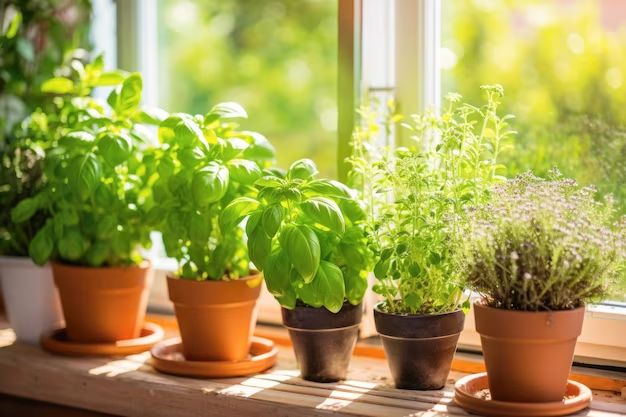Growing herbs in a window planter is an excellent way to have fresh herbs readily available in your kitchen. Many popular culinary herbs like basil, parsley, thyme, oregano, sage, rosemary, chives, and mint can thrive in a window planter with proper care. Here are some tips on how to successfully grow herbs in a window planter.
Page Contents
Choosing the Right Planter
When selecting a planter for growing herbs in a window, consider the following:
- Material – Plastic, ceramic, wood, or metal planters all work well. Make sure there are drainage holes in the bottom.
- Size – The planter should be large enough to hold at least 6 inches of soil for the herb roots. A 12-16 inch wide planter is usually a good size.
- Depth – At least 6-8 inches deep to allow for root growth.
A rectangular or square shape will fit well on most windowsills. Self-watering planters or pots with built-in reservoirs can help prevent drying out between waterings.
Choosing the Right Soil
Herbs need a loose, fertile soil that drains well. A commercial potting mix formulated for herbs or vegetables is ideal. You can also make your own mix:
- 1 part compost or peat moss for moisture retention
- 1 part perlite or vermiculite to improve drainage
- 1 part sterile potting soil for nutrients
Avoid using garden soil which may contain diseases. Mix the ingredients together thoroughly before filling your planter. Make sure the soil is moist but not soggy.
Selecting Herbs to Grow
When choosing which herbs to grow in a window box, opt for small, compact varieties. The following are good choices:
| Herb | Varieties |
|---|---|
| Basil | Spicy Globe, Bush, Compact |
| Oregano | Compactum |
| Thyme | French, English, Lemon |
| Sage | Compact, Dwarf Garden |
| Parsley | Curly, Italian Flat Leaf |
| Mint | Orange, Peppermint, Spearmint |
| Chives | Common, Garlic |
| Rosemary | Prostrate |
Avoid large varieties like bush basil and full size oregano which can outgrow a small planter quickly.
Planting and Care
Follow these tips for planting and caring for herbs in a window planter:
- Start seeds indoors 6-8 weeks before the last frost or purchase transplants.
- Space the herbs 6-12 inches apart depending on variety. Plant them at the same level they were growing in their nursery pot.
- Trim herbs frequently to encourage bushy growth. Pinch off flower buds.
- Water whenever the top inch of soil dries out. Use water-soluble fertilizer monthly.
- Make sure the planter gets at least 6 hours of sun daily for best growth.
- Turn the planter periodically so all sides get even light exposure.
- Monitor for pests like aphids and treat promptly to keep population down.
- Cut back herbs by 1/3 before winter if bringing the planter indoors.
- Discard herbs after 1-2 years when they become woody and start declining.
Ideal Growing Conditions
Here are the ideal growing conditions for herbs thrived in a window planter:
- Light – At least 6-8 hours of full sun daily. Southern or western exposure is best. Supplement with grow lights if needed.
- Temperature – Daytime temps between 70-80°F, nighttime around 60-70°F.
- Water – Let soil dry out between waterings but don’t let it get bone dry. Moderate moisture.
- Soil – Well-draining potting mix with added organic matter like compost.
- Fertilizer – Use all-purpose water soluble fertilizer every 2-4 weeks during growing season.
- Container Size – At least 12 inches wide and 6 inches deep for most herbs.
Mimicking these ideal conditions as much as possible will help ensure your herbs thrive and reach their full potential in the window planter.
Troubleshooting Common Issues
If you notice any of the following problems, here are some troubleshooting tips:
- Poor growth – This is usually caused by insufficient light. Try a different window, add grow lights, or supplement with a fertilizer.
- Yellowing leaves – Overwatering can cause yellow leaves and root rot. Allow soil to dry out between waterings.
- Leggy growth – Leggy herbs need more light. Rotate the planter and pinch back stems to encourage bushy growth.
- White spots or mold – Improve air circulation and make sure there is not excessive moisture on leaves. Remove affected foliage.
Catching problems early and making adjustments to light, water and fertilizer will help you get your herbs back on track.
Keeping Herbs Fresh Longer
To maximize use of your homegrown herbs and keep them fresh longer:
- Pick leaves in the morning after any dew has dried.
- Use scissors for clean cuts rather than tearing or bruising.
- Rinse gently and pat dry with paper towels.
- Strip leaves off thicker stemmed herbs like thyme, oregano, sage.
- Store loosely wrapped in paper towels in the refrigerator.
- Place cut ends in a glass of water like a bouquet and cover with a plastic bag.
- Chop what you need and keep rest intact for longer shelf life.
- Freeze extras in ice cube trays covered with water or olive oil.
- Dry excess herbs completely before storing in airtight containers.
Conclusion
Growing culinary herbs in a window planter is simple and rewarding. Choosing compact varieties suited to containers, positioning the planter for sufficient sun exposure, providing adequate soil and nutrients, and proper watering are the keys to success. Common kitchen herbs like parsley, basil, thyme and oregano can thrive in a well-cared for window planter and provide a convenient source of garden fresh flavor right in your kitchen.
